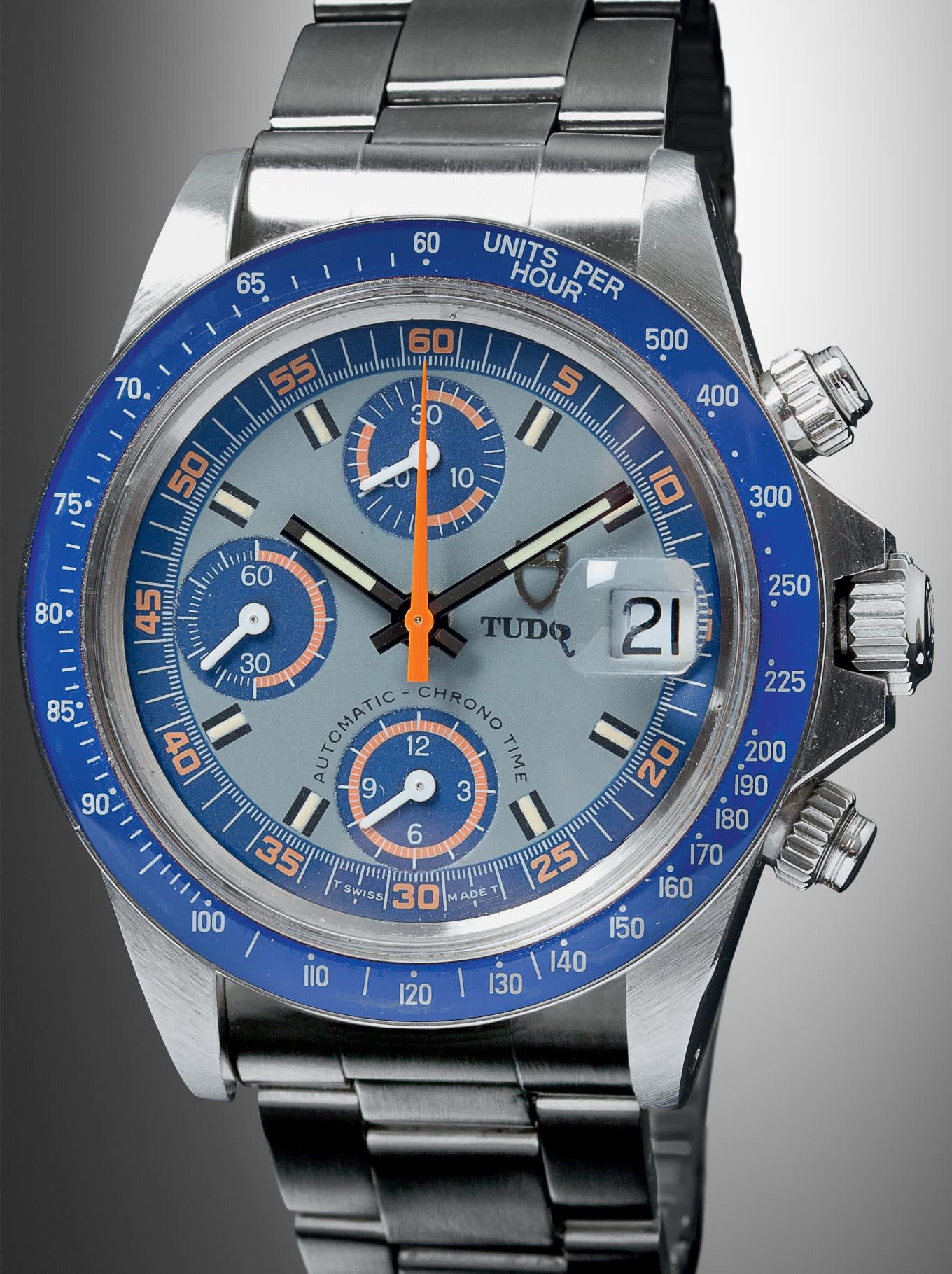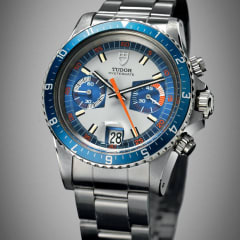
A UNIQUE STYLEThe chronographs: from 1976 to 1991
For nearly half a century, TUDOR has left its mark on the history of chronographs with products of strong identity, unique style and uncompromising quality. By proving equal to the task, by kindling passion, by constantly improving its products and by offering models clearly belonging to their era but retaining their own distinct identity, TUDOR has earned a place apart in the field of sports chronographs, embodied in the development of four successive families of products. The year 1976 saw the launch of the third family of TUDOR chronographs, known as “Big Block” in the watch collection milieu, and the introduction of an important innovation. With the Prince Oysterdate models, the brand presented its first chronographs equipped with a self-winding mechanical movement and confirmed what the Oysterdate family had begun. TUDOR offered immediately recognisable chronographs with excellent technical qualities.

THIRD SERIES: TUDOR OYSTERDATE “BIG BLOCK”
In 1976, TUDOR presented a new family of products which constituted a small revolution for the brand. Indeed, these new Prince Oysterdate watches were the first chronographs in the history of TUDOR to be equipped with self-winding movements. Listed under the name Prince Oysterdate, they were also known by the names “AUTOMATIC CHRONO TIME” or “CHRONO TIME” referring to the signatures displayed on their dials. While their cases retained the general lines of the previous families, they became thicker to accommodate the rotor of the self-winding movement, which earned them the nickname “Big Block” in collectors’ circles. The name “Big Block” endured in the following 79100 series introduced in 1989, which featured only minimal modifications. Like preceding generations, the 9400 series consists of three references distinguished one from the other by their type of bezel, a feature that is also present on the “Big Block” models of the 79100 series. Likewise, several dial variations were available under the same reference number. Two aesthetic trends characterise them: one freely inspired by the spirit of the dials of the previous two series, sometimes called “Exotic” by collectors; the other, much more illustrated in the catalogue, emphasising a significant dial-counter contrast with black and white or sliver and white combinations. The movement at the heart of these new chronographs was the Valjoux Calibre 7750. Having the same diameter as the manually wound Valjoux 234, 30.4 mm or 13 lines, it was 1.5 mm thicker than the latter and had a frequency of 28,800 beats per hour. Its chronograph mechanism was a highly reliable cam and oscillating pinion system. The architecture of this new movement brought about a reorganisation of the dial with the addition of an hour counter, the transfer of the group of counters towards the left of the dial, and the relocation of the date aperture to 3 o’clock.

TUDOR PRINCE OYSTERDATE “BIG BLOCK” 9430/0
In spite of its official name, the Prince Oysterdate chronograph series does not display its name on the dial. Instead the indications “CHRONO TIME”, as on the 1976 model presented here, or “AUTOMATIC CHRONO TIME” on other dial variations are displayed. The version of reference 9430/0 illustrated on the following page presents a black dial with three white counters with pronounced striations on two levels. The introduction of the self-winding Valjoux chronograph Calibre 7750 brought an additional innovation to the Oysterdate chronographs in the form of a rapid date change function. Indeed, while on the previous series one had to turn the hands around the dial many times to set the date after a period of non-use, now the position of the winding crown allowed direct access to the date disc.
TUDOR PRINCE OYSTERDATE “BIG BLOCK EXOTIC” 9430/0
A dial variation of reference 9430/0, sometimes called “Exotic” by collectors, who considered it an alternative to the main black and white versions because it was little illustrated in the catalogue, owed much to its 7000 and 7100 series predecessors. With an inspired colour combination, a minute track whose divisions evoked a casino roulette wheel, and an orange seconds hand similar to those on the first series, the chronograph presented here and produced in 1978 combined the spirit of the brand’s chronographic beginnings with contemporary technology, thanks to the Valjoux 7750 self-winding movement introduced two years earlier. The dial did not bear the inscription “OYSTERDATE”, but the indication “AUTOMATIC CHRONO TIME” curving around the hour counter located at 6 o’clock.

TUDOR PRINCE OYSTERDATE “BIG BLOCK EXOTIC SQUARE GUARDS” 9420/0
Some series stood out due to a special feature. They were equipped with a unique alternative square-shaped type of protection for the winding crown, which gave them an even more dignified style. This specific feature was known among collectors as “Square Guards”. The dial of reference 9420/0 of 1985 shown here was called “Exotic”. Grey with blue areas and orange inscriptions, it was reminiscent of a colour combination made famous by the TUDOR Oysterdate “Montecarlo”. In another nod to the original TUDOR chronograph dials, the hour markers were painted. Its vivid blue Plexiglas bezel was also inherited from its ancestor, reference 7149/0.
TUDOR PRINCE OYSTERDATE “BIG BLOCK” 79160
In 1989, references 79100 were introduced into the catalogue to replace the 9400s. Their case remained identical, which allowed them to retain the nickname “Big Block”. The changes made in this new series were minimal and mainly aesthetic. Reference 79160 of 1989 pictured here allows us to observe the details. The dial bore the indication “OYSTERDATE”. The case and winding crown were still signed Rolex, but the bracelet from then on would bear the TUDOR logo on its clasp. The self-winding movement at its heart was still the Valjoux Calibre 7750.

TUDOR PRINCE OYSTERDATE “BIG BLOCK” 79170
This example of the 79170 chronograph produced in 1992 was the successor to 9421/0 with a rotatable bezel and retained from its ancestor the thicker case which earned it the nickname “Big Block”. Its Oyster bracelet in steel was no longer signed Rolex, but TUDOR – although it still had the same 78360 reference number.














